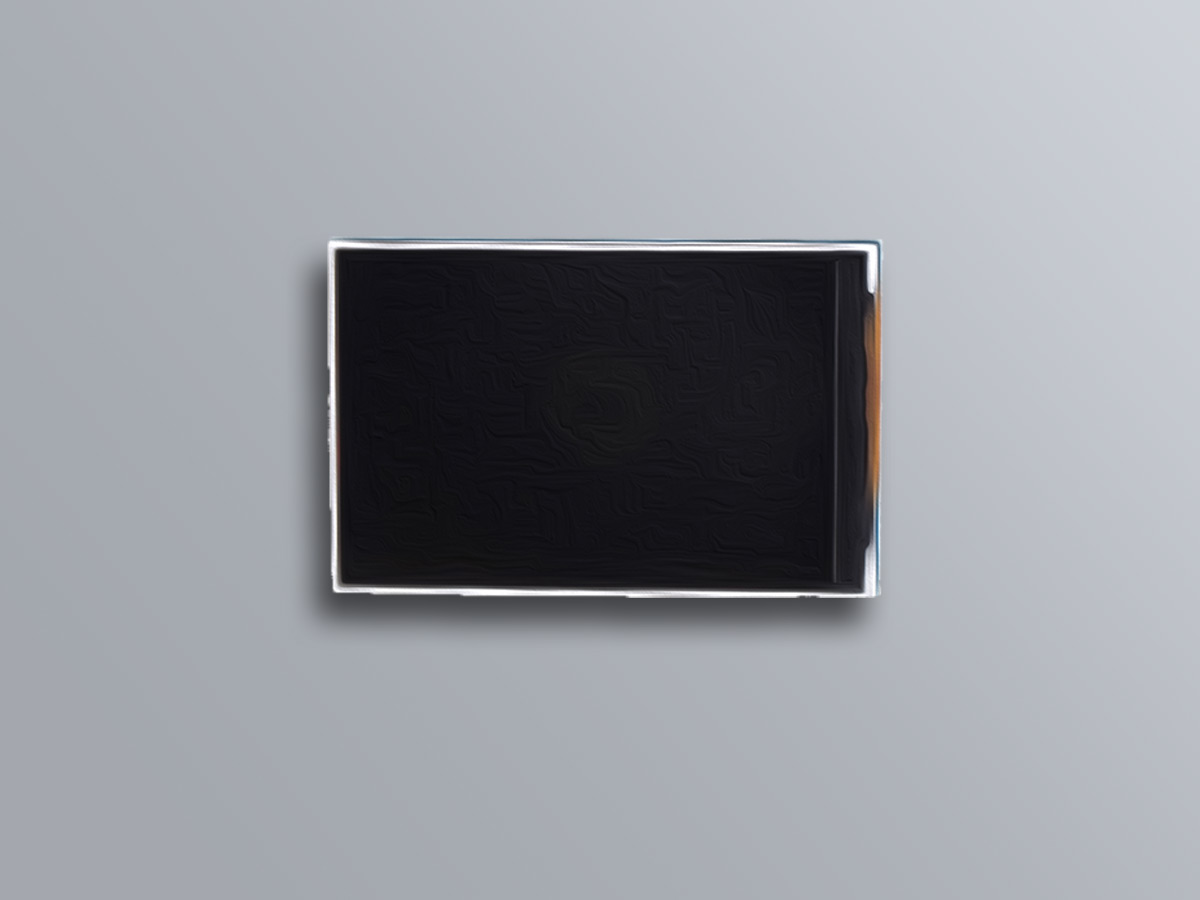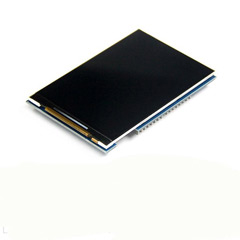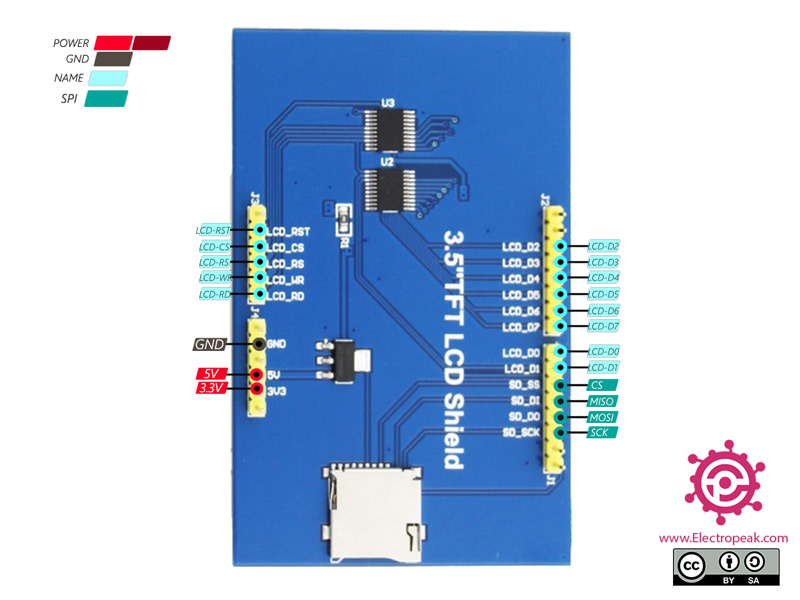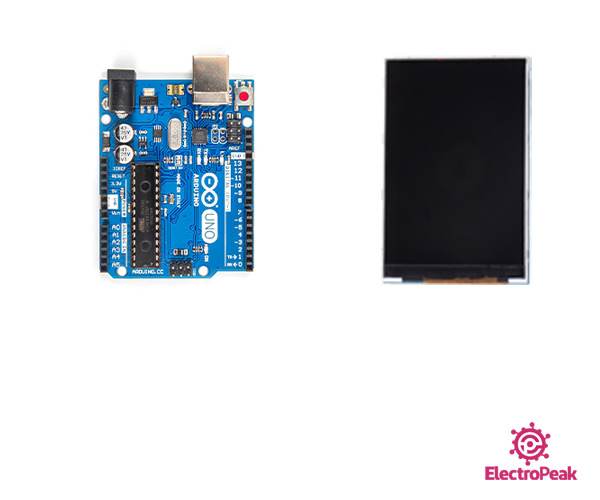3.5 INCH TFT DISPLAY Features
This module is a 3.5-inch TFT LCD module with “320X480” resolution and 65K color display. It is suitable for Arduino Uno and Mega2560 development boards, and also supports SD card expansion function. It uses 8-bit parallel port communication, and the driver IC is ILI9486.
You can download the datasheet of this module here.
3.5 INCH TFT Display Pinout
This module has 20 pins:
- 5V: Module power supply – 5 V
- 3.3V: Module power supply – 3.3 V
- GND: Ground
- LCD_RST: LCD bus reset signal, low level reset
- LCD_CS: LCD bus chip select signal, low level enable
- LCD_RS: LCD bus command / data selection signal, low level: command, high level: data
- LCD_WR: LCD bus write signal
- LCD_RD: LCD bus read signal
- LCD_D0: LCD 8-bit data Bit0
- LCD_D1: LCD 8-bit data Bit1
- LCD_D2: LCD 8-bit data Bit2
- LCD_D3: LCD 8-bit data Bit3
- LCD_D4: LCD 8-bit data Bit4
- LCD_D5: LCD 8-bit data Bit5
- LCD_D6: LCD 8-bit data Bit6
- LCD_D7: LCD 8-bit data Bit7
- SD_SS: SD card SPI bus chip select signal, low level enable
- SD_DI: SD card SPI bus MOSI signal
- SD_DO: SD card SPI bus MOSI signal
- SD_SCK: SD card SPI bus clock signal
You can see the pinout of this module in the image below.
Required Materials
Hardware Components
Software Apps
Interfacing 2.4 INCH TFT Display with Arduino
Step 1: Circuit
The 3.5-inch display is a ready-made shield for Arduino Uno, which can also be placed on the Arduino Mega. The pins of this shield are designed to be easily installed on the Arduino. The bad point about these modules is that they use all Arduino Uno pins.
Step 2: Code
First, download the following code.
Now open it and follow the path below.
- Demo\Demo_Arduino\Install libraries
Copy the LCDWIKI_KBV folder to your Arduino library.
Then enter the folder and follow the path below.
- 2. Example\Example_02_colligate_test\colligate_test
Run the Arduino file in the folder and look for the following line.
LCDWIKI_KBV my_lcd(ILI9341,A3,A2,A1,A0,A4); //model,cs,cd,wr,rd,reset Then uncomment it and upload the code to your Arduino.
// IMPORTANT: LCDWIKI_KBV LIBRARY MUST BE SPECIFICALLY
// CONFIGURED FOR EITHER THE TFT SHIELD OR THE BREAKOUT BOARD.
//This program is a demo of how to use most of the functions
//of the library with a supported display modules.
//Set the pins to the correct ones for your development shield or breakout board.
//when using the BREAKOUT BOARD only and using these 8 data lines to the LCD,
//pin usage as follow:
// CS CD WR RD RST D0 D1 D2 D3 D4 D5 D6 D7
//Arduino Uno A3 A2 A1 A0 A4 8 9 2 3 4 5 6 7
//Arduino Mega A3 A2 A1 A0 A4 8 9 2 3 4 5 6 7
//the 16bit mode only use in Mega.you must modify the mode in the file of lcd_mode.h
//when using the BREAKOUT BOARD only and using these 16 data lines to the LCD,
//pin usage as follow:
// CS CD WR RD RST D0 D1 D2 D3 D4 D5 D6 D7 D8 D9 D10 D11 D12 D13 D14 D15
//Arduino Mega 40 38 39 44 41 37 36 35 34 33 32 31 30 22 23 24 25 26 27 28 29
//Remember to set the pins to suit your display module!
#include <LCDWIKI_GUI.h> //Core graphics library
#include <LCDWIKI_KBV.h> //Hardware-specific library
//the definiens of 8bit mode as follow:
//if the IC model is known or the modules is unreadable,you can use this constructed function
//LCDWIKI_KBV my_lcd(ILI9341,A3,A2,A1,A0,A4); //model,cs,cd,wr,rd,reset
//LCDWIKI_KBV my_lcd(ILI9325,A3,A2,A1,A0,A4); //model,cs,cd,wr,rd,reset
//LCDWIKI_KBV my_lcd(ILI9328,A3,A2,A1,A0,A4); //model,cs,cd,wr,rd,reset
//LCDWIKI_KBV my_lcd(HX8357D,A3,A2,A1,A0,A4); //model,cs,cd,wr,rd,reset
//LCDWIKI_KBV my_lcd(HX8347G,A3,A2,A1,A0,A4); //model,cs,cd,wr,rd,reset
//LCDWIKI_KBV my_lcd(HX8347I,A3,A2,A1,A0,A4); //model,cs,cd,wr,rd,reset
LCDWIKI_KBV my_lcd(ILI9486,A3,A2,A1,A0,A4); //model,cs,cd,wr,rd,reset
//LCDWIKI_KBV my_lcd(ST7735S,A3,A2,A1,A0,A4); //model,cs,cd,wr,rd,reset
//if the IC model is not known and the modules is readable,you can use this constructed function
//LCDWIKI_KBV my_lcd(240,320,A3,A2,A1,A0,A4);//width,height,cs,cd,wr,rd,reset
//LCDWIKI_KBV my_lcd(320,480,A3,A2,A1,A0,A4);//width,height,cs,cd,wr,rd,reset
//the definiens of 16bit mode as follow:
//if the IC model is known or the modules is unreadable,you can use this constructed function
//LCDWIKI_KBV my_lcd(ILI9341,40,38,39,44,41); //model,cs,cd,wr,rd,reset
//LCDWIKI_KBV my_lcd(ILI9325,40,38,39,44,41); //model,cs,cd,wr,rd,reset
//LCDWIKI_KBV my_lcd(ILI9328,40,38,39,44,41); //model,cs,cd,wr,rd,reset
//LCDWIKI_KBV my_lcd(HX8357D,40,38,39,44,41); //model,cs,cd,wr,rd,reset
//LCDWIKI_KBV my_lcd(HX8347G,40,38,39,44,41); //model,cs,cd,wr,rd,reset
//LCDWIKI_KBV my_lcd(HX8347I,40,38,39,44,41); //model,cs,cd,wr,rd,reset
//LCDWIKI_KBV my_lcd(ILI9486,40,38,39,44,41); //model,cs,cd,wr,rd,reset
//LCDWIKI_KBV mylcd(ILI9488,40,38,39,44,41); //model,cs,cd,wr,rd,reset
//LCDWIKI_KBV mylcd(ILI9481,40,38,39,44,41); //model,cs,cd,wr,rd,reset
//LCDWIKI_KBV my_lcd(ST7735S,40,38,39,44,41); //model,cs,cd,wr,rd,reset
//if the IC model is not known and the modules is readable,you can use this constructed function
//LCDWIKI_KBV my_lcd(240,320,40,38,39,44,41);//width,height,cs,cd,wr,rd,reset for
//LCDWIKI_KBV my_lcd(320,480,40,38,39,44,41);//width,height,cs,cd,wr,rd,reset
//display main surface
unsigned long show_text(void)
{
unsigned long time_start = micros();
my_lcd.Set_Draw_color(32, 0,255);
my_lcd.Fill_Rectangle(0, 0, my_lcd.Get_Display_Width()-1, 14);
my_lcd.Set_Text_colour(0, 255, 0);
my_lcd.Set_Text_Size(1);
my_lcd.Set_Text_Mode(1);
my_lcd.Print_String("* Universal Color TFT Display Library *", CENTER, 3);
my_lcd.Set_Draw_color(128, 128, 128);
my_lcd.Fill_Rectangle(0, my_lcd.Get_Display_Height()-15, my_lcd.Get_Display_Width()-1, my_lcd.Get_Display_Height()-1);
my_lcd.Set_Text_colour(255, 255, 255);
my_lcd.Set_Text_Size(1);
my_lcd.Set_Text_Mode(1);
my_lcd.Print_String("<http://abcdefghijklmnopq.1234567890.com>", CENTER, my_lcd.Get_Display_Height()-11);
my_lcd.Set_Draw_color(255, 0, 0);
my_lcd.Draw_Rectangle(0, 15, my_lcd.Get_Display_Width()-1, my_lcd.Get_Display_Height()-16);
return micros() - time_start;
}
//display triangle functions
unsigned long show_triangle_function(void)
{
uint16_t i;
unsigned long time_start = micros();
// Draw crosshairs
my_lcd.Set_Draw_color(0, 0, 255);
my_lcd.Draw_Fast_VLine(my_lcd.Get_Display_Width()/2-1, 16, my_lcd.Get_Display_Height()- 32);
my_lcd.Draw_Fast_HLine(1, my_lcd.Get_Display_Height()/2-1, my_lcd.Get_Display_Width()-2);
for(i = 1;i <= (my_lcd.Get_Display_Height()- 32)/2/10;i++)
{
my_lcd.Draw_Fast_HLine(my_lcd.Get_Display_Width()/2-1-2, my_lcd.Get_Display_Height()/2-1-i*10, 5);
my_lcd.Draw_Fast_HLine(my_lcd.Get_Display_Width()/2-1-2, my_lcd.Get_Display_Height()/2-1+i*10, 5);
}
for(i = 1;i <= (my_lcd.Get_Display_Width()-2)/2/10;i++)
{
my_lcd.Draw_Fast_VLine(my_lcd.Get_Display_Width()/2-1-i*10, my_lcd.Get_Display_Height()/2-1-2, 5);
my_lcd.Draw_Fast_VLine(my_lcd.Get_Display_Width()/2-1+i*10, my_lcd.Get_Display_Height()/2-1-2, 5);
}
// Draw sin lines
my_lcd.Set_Text_colour(0, 255, 255);
my_lcd.Set_Text_Back_colour(0,0,0);
my_lcd.Set_Text_Size(1);
my_lcd.Set_Text_Mode(0);
my_lcd.Print_String("sin",5,17);
my_lcd.Set_Draw_color(0, 255, 255);
for (i=1; i<my_lcd.Get_Display_Width()-2; i++)
{
my_lcd.Draw_Pixel(i,my_lcd.Get_Display_Height()/2-1+(sin(((i*1.13)*3.14)/180)*95));
}
// Draw cos lines
my_lcd.Set_Text_colour(0, 255, 0);
my_lcd.Set_Text_Back_colour(0,0,0);
my_lcd.Set_Text_Size(1);
my_lcd.Set_Text_Mode(0);
my_lcd.Print_String("cos",5,25);
my_lcd.Set_Draw_color(0, 255, 0);
for (i=1; i<my_lcd.Get_Display_Width()-2; i++)
{
my_lcd.Draw_Pixel(i,my_lcd.Get_Display_Height()/2-1+(cos(((i*1.13)*3.14)/180)*95));
}
// Draw tan lines
my_lcd.Set_Text_colour(255, 255, 0);
my_lcd.Set_Text_Back_colour(0,0,0);
my_lcd.Set_Text_Size(1);
my_lcd.Set_Text_Mode(0);
my_lcd.Print_String("tan",5,33);
my_lcd.Set_Draw_color(255, 255, 0);
for (i=1; i<my_lcd.Get_Display_Width()-2; i++)
{
my_lcd.Draw_Pixel(i,my_lcd.Get_Display_Height()/2-1+(tan(((i*1.13)*3.14)/180)*10));
}
// Draw cot lines
my_lcd.Set_Text_colour(255, 0, 0);
my_lcd.Set_Text_Back_colour(0,0,0);
my_lcd.Set_Text_Size(1);
my_lcd.Set_Text_Mode(0);
my_lcd.Print_String("cot",5,41);
my_lcd.Set_Draw_color(255, 0, 0);
for (i=1; i<my_lcd.Get_Display_Width()-2; i++)
{
my_lcd.Draw_Pixel(i,my_lcd.Get_Display_Height()/2-1+1/(tan(((i*1.13)*3.14)/180)*0.1));
}
return micros()-time_start;
}
// Draw a moving sinewave
unsigned long show_sinewave(void)
{
uint16_t buf[my_lcd.Get_Display_Width()-2],x = 1,i,y;
unsigned long time_start = micros();
int16_t wid = my_lcd.Get_Display_Width();
int16_t t;
float k;
if(wid == 320)
{
t = 20;
k = 1.1;
}
else
{
t = 15;
k = 0.7;
}
my_lcd.Set_Draw_color(0, 0, 255);
my_lcd.Draw_Fast_VLine(my_lcd.Get_Display_Width()/2-1, 16, my_lcd.Get_Display_Height()- 32);
my_lcd.Draw_Fast_HLine(1, my_lcd.Get_Display_Height()/2-1, my_lcd.Get_Display_Width()-2);
for (i=1; i<((my_lcd.Get_Display_Width()-2)*t); i++)
{
x++;
if (x==my_lcd.Get_Display_Width()-1)
{
x=1;
}
if (i>my_lcd.Get_Display_Width()-1)
{
if ((x==my_lcd.Get_Display_Width()/2-1)||(buf[x-1]==my_lcd.Get_Display_Height()/2-1))
{
my_lcd.Set_Draw_color(0, 0, 255);
}
else
{
my_lcd.Set_Draw_color(0, 0, 0);
}
my_lcd.Draw_Pixel(x,buf[x-1]);
}
my_lcd.Set_Draw_color(255, 64, 255);
y=my_lcd.Get_Display_Height()/2-1+(sin(((i*k)*3.14)/180)*(90-(i/100)));
my_lcd.Draw_Pixel(x,y);
buf[x-1]=y;
}
return micros()- time_start;
}
// Draw some filled rectangles
unsigned long show_fill_rectangle(void)
{
uint16_t i;
unsigned long time_start = micros();
uint16_t side_len = (my_lcd.Get_Display_Height()-40)/5;
uint16_t x_spec = (my_lcd.Get_Display_Width()-5*side_len)/2;
uint16_t y_spec = (my_lcd.Get_Display_Height()-5*side_len)/2;
for(i = 0;i<5;i++)
{
switch (i)
{
case 0:
my_lcd.Set_Draw_color(255,0,255);
break;
case 1:
my_lcd.Set_Draw_color(255,0,0);
break;
case 2:
my_lcd.Set_Draw_color(0,255,0);
break;
case 3:
my_lcd.Set_Draw_color(0,0,255);
break;
case 4:
my_lcd.Set_Draw_color(255,255,0);
break;
default:
break;
}
my_lcd.Fill_Rectangle(x_spec+i*side_len-1, y_spec+i*side_len-1, x_spec+(i+1)*side_len-1, y_spec+(i+1)*side_len-1);
my_lcd.Fill_Rectangle(x_spec+i*side_len-1, y_spec+(5-i)*side_len-1, x_spec+(i+1)*side_len-1, y_spec+(4-i)*side_len-1);
}
return micros()- time_start;
}
// Draw some filled round rectangles
unsigned long show_fill_round_rectangle(void)
{
uint16_t i;
unsigned long time_start = micros();
uint16_t side_len = (my_lcd.Get_Display_Height()-40)/5;
uint16_t x_spec = (my_lcd.Get_Display_Width()-5*side_len)/2;
uint16_t y_spec = (my_lcd.Get_Display_Height()-5*side_len)/2;
for(i = 0;i<5;i++)
{
switch (i)
{
case 0:
my_lcd.Set_Draw_color(255,0,255);
break;
case 1:
my_lcd.Set_Draw_color(255,0,0);
break;
case 2:
my_lcd.Set_Draw_color(0,255,0);
break;
case 3:
my_lcd.Set_Draw_color(0,0,255);
break;
case 4:
my_lcd.Set_Draw_color(255,255,0);
break;
default:
break;
}
my_lcd.Fill_Round_Rectangle(x_spec+i*side_len-1, y_spec+i*side_len-1, x_spec+(i+1)*side_len-1, y_spec+(i+1)*side_len-1,10);
my_lcd.Fill_Round_Rectangle(x_spec+i*side_len-1, y_spec+(5-i)*side_len-1, x_spec+(i+1)*side_len-1, y_spec+(4-i)*side_len-1,10);
}
return micros()- time_start;
}
// Draw some filled circles
unsigned long show_fill_circle(void)
{
uint16_t i;
unsigned long time_start = micros();
uint16_t r_len = (my_lcd.Get_Display_Height()-40)/5/2;
uint16_t x_spec = (my_lcd.Get_Display_Width()-5*r_len*2)/2;
uint16_t y_spec = (my_lcd.Get_Display_Height()-5*r_len*2)/2;
for(i = 0;i<5;i++)
{
switch (i)
{
case 0:
my_lcd.Set_Draw_color(255,0,255);
break;
case 1:
my_lcd.Set_Draw_color(255,0,0);
break;
case 2:
my_lcd.Set_Draw_color(0,255,0);
break;
case 3:
my_lcd.Set_Draw_color(0,0,255);
break;
case 4:
my_lcd.Set_Draw_color(255,255,0);
break;
default:
break;
}
my_lcd.Fill_Circle(x_spec+r_len+i*r_len*2-1, y_spec+r_len+i*r_len*2-1,r_len);
my_lcd.Fill_Circle(x_spec+r_len+i*r_len*2-1, y_spec+(5-i)*r_len*2-r_len-1,r_len);
}
return micros()- time_start;
}
// Draw some filled triangles
unsigned long show_fill_triangle(void)
{
uint16_t i;
unsigned long time_start = micros();
uint16_t h_len = (my_lcd.Get_Display_Height()-40)/5;
uint16_t side_len = (h_len*115)/100;
uint16_t x_spec = (my_lcd.Get_Display_Width()-5*side_len)/2;
uint16_t y_spec = (my_lcd.Get_Display_Height()-5*h_len)/2;
for(i = 0;i<5;i++)
{
switch (i)
{
case 0:
my_lcd.Set_Draw_color(255,0,255);
break;
case 1:
my_lcd.Set_Draw_color(255,0,0);
break;
case 2:
my_lcd.Set_Draw_color(0,255,0);
break;
case 3:
my_lcd.Set_Draw_color(0,0,255);
break;
case 4:
my_lcd.Set_Draw_color(255,255,0);
break;
default:
break;
}
my_lcd.Fill_Triangle(x_spec+i*side_len-1,y_spec+(i+1)*h_len-1,x_spec+side_len/2+i*side_len-1,y_spec+i*h_len-1,x_spec+(i+1)*side_len-1,y_spec+(i+1)*h_len-1);
my_lcd.Fill_Triangle(x_spec+i*side_len-1,y_spec+(5-i)*h_len-1,x_spec+side_len/2+i*side_len-1,y_spec+(4-i)*h_len-1,x_spec+(i+1)*side_len-1,y_spec+(5-i)*h_len-1);
}
return micros()- time_start;
}
// Draw some lines in a pattern
unsigned long show_grid_lines(void)
{
uint16_t i;
unsigned long time_start = micros();
int16_t wid = my_lcd.Get_Display_Width();
float k;
if(wid == 320)
{
k = 1.44;
}
else
{
k = 1.6;
}
my_lcd.Set_Draw_color(255,0,0);
for (i=16; i<my_lcd.Get_Display_Height()-17; i+=5)
{
my_lcd.Draw_Line(1, i, (i*k)-10, my_lcd.Get_Display_Height()-17);
}
my_lcd.Set_Draw_color(255,0,0);
for (i=my_lcd.Get_Display_Height()-17; i>16; i-=5)
{
my_lcd.Draw_Line(my_lcd.Get_Display_Width()-2, i, (i*k)-11, 16);
}
my_lcd.Set_Draw_color(0,255,255);
for (i=my_lcd.Get_Display_Height()-16; i>16; i-=5)
{
my_lcd.Draw_Line(1, i, (my_lcd.Get_Display_Height()-17)*k+10-(i*k), 16);
}
my_lcd.Set_Draw_color(0,255,255);
for (int i=15; i<my_lcd.Get_Display_Height()-17; i+=5)
{
my_lcd.Draw_Line(my_lcd.Get_Display_Width()-2, i, (my_lcd.Get_Display_Height()-17)*k+10-(i*k), my_lcd.Get_Display_Height()-17);
}
return micros()- time_start;
}
// Draw some random pixels
unsigned long show_random_pixels(void)
{
uint16_t i;
unsigned long time_start = micros();
for(i = 0;i< 10000;i++)
{
my_lcd.Set_Draw_color(random(255),random(255),random(255));
my_lcd.Draw_Pixel(2+random(my_lcd.Get_Display_Width()-4),17+random(my_lcd.Get_Display_Height()-34));
}
return micros()- time_start;
}
// Draw some random lines
unsigned long show_random_lines(void)
{
uint16_t i;
unsigned long time_start = micros();
for(i = 0;i< 300;i++)
{
my_lcd.Set_Draw_color(random(255),random(255),random(255));
my_lcd.Draw_Line(2+random(my_lcd.Get_Display_Width()-4),17+random(my_lcd.Get_Display_Height()-34),2+random(my_lcd.Get_Display_Width()-4),17+random(my_lcd.Get_Display_Height()-34));
}
return micros()- time_start;
}
// Draw some random rectangles
unsigned long show_random_rectangles(void)
{
uint16_t i;
unsigned long time_start = micros();
for(i = 0;i< 150;i++)
{
my_lcd.Set_Draw_color(random(255),random(255),random(255));
my_lcd.Draw_Rectangle(2+random(my_lcd.Get_Display_Width()-4),17+random(my_lcd.Get_Display_Height()-34),2+random(my_lcd.Get_Display_Width()-4),17+random(my_lcd.Get_Display_Height()-34));
}
return micros()- time_start;
}
// Draw some random round rectangles
unsigned long show_random_round_rectangles(void)
{
uint16_t i;
unsigned long time_start = micros();
for(i = 0;i< 150;i++)
{
my_lcd.Set_Draw_color(random(255),random(255),random(255));
my_lcd.Draw_Round_Rectangle(2+random(my_lcd.Get_Display_Width()-4),17+random(my_lcd.Get_Display_Height()-34),2+random(my_lcd.Get_Display_Width()-4),17+random(my_lcd.Get_Display_Height()-34),5);
}
return micros()- time_start;
}
// Draw some random circles
unsigned long show_random_circles(void)
{
uint16_t i;
unsigned long time_start = micros();
for(i = 0;i< 150;i++)
{
my_lcd.Set_Draw_color(random(255),random(255),random(255));
my_lcd.Draw_Circle(41+random(my_lcd.Get_Display_Width()-82), 56+random(my_lcd.Get_Display_Height()-112), random(40));
}
return micros()- time_start;
}
// Draw some random triangles
unsigned long show_random_triangles(void)
{
uint16_t i;
unsigned long time_start = micros();
for(i = 0;i< 150;i++)
{
my_lcd.Set_Draw_color(random(255),random(255),random(255));
my_lcd.Draw_Triangle(2+random(my_lcd.Get_Display_Width()-4),17+random(my_lcd.Get_Display_Height()-34),2+random(my_lcd.Get_Display_Width()-4),17+random(my_lcd.Get_Display_Height()-34),2+random(my_lcd.Get_Display_Width()-4),17+random(my_lcd.Get_Display_Height()-34));
}
return micros()- time_start;
}
// Draw some random bit maps
unsigned long show_random_bit_map(void)
{
uint16_t buf[48],i;
unsigned long time_start = micros();
int16_t len = (my_lcd.Get_Display_Height()*3/4)/6;
for(i = 0;i< 48; i++)
{
my_lcd.Set_Draw_color(random(255), random(255), random(255));
buf[i] = my_lcd.Get_Draw_color();
}
for(i = 1;i<=6;i++)
{
my_lcd.Draw_Bit_Map(my_lcd.Get_Display_Width()/2-1-((len/2)*4/3)*i, my_lcd.Get_Display_Height()/2-1-(len/2)*i, 8, 6, buf, i*(len/6));
delay(100);
}
return micros()- time_start;
}
//Clear the screen
void clear_screen(void)
{
delay(2000);
my_lcd.Set_Draw_color(0, 0, 0);
my_lcd.Fill_Rectangle(1, 16, my_lcd.Get_Display_Width()-2, my_lcd.Get_Display_Height()-17);
}
unsigned long (*show_function[])(void) =
{
show_text,
show_triangle_function,
show_sinewave,
show_fill_rectangle,
show_fill_round_rectangle,
show_fill_circle,
show_fill_triangle,
show_grid_lines,
show_random_pixels,
show_random_lines,
show_random_rectangles,
show_random_round_rectangles,
show_random_circles,
show_random_triangles,
show_random_bit_map,
};
uint8_t *show_str[]=
{
"show text :",
"show triangle function :",
"show sinewave :",
"show fill rectangle :",
"show fill round rectangle :",
"show fill circle :",
"show fill triangle :",
"show grid lines :",
"show random pixels :",
"show random lines :",
"show random rectangles :",
"show random round rectangles :",
"show random circles :",
"show random triangles :",
"show random bit_map :"
};
//display the running time of programs
unsigned long show_total_time(void)
{
uint16_t i;
unsigned long buf[15];
unsigned long time_start = micros();
for(i = 0;i< 15;i++)
{
buf[i] = show_function[i]();
clear_screen();
}
for(i = 0;i<15; i++)
{
my_lcd.Set_Text_colour(255, 165, 0);
my_lcd.Set_Text_Size(1);
my_lcd.Set_Text_Mode(1);
my_lcd.Print_String(show_str[i], (my_lcd.Get_Display_Width()-260)/2-1, (my_lcd.Get_Display_Height()-150)/2+i*10-1);
my_lcd.Set_Text_colour(0, 255, 0);
my_lcd.Print_Number_Int(buf[i], (my_lcd.Get_Display_Width()-260)/2-1+200, (my_lcd.Get_Display_Height()-150)/2+i*10-1, 0, ' ', 10);
}
delay(5000);
return micros()- time_start;
}
//display ending and total running time
void show_end(unsigned long run_time)
{
my_lcd.Fill_Screen(0, 255, 255);
my_lcd.Set_Draw_color(255, 0, 0);
my_lcd.Fill_Round_Rectangle(my_lcd.Get_Display_Width()/2-1-120+1, my_lcd.Get_Display_Height()/2-1-60+1, my_lcd.Get_Display_Width()/2-1+120-1, my_lcd.Get_Display_Height()/2-1+60-1,5);
my_lcd.Set_Text_colour(0, 255, 255);
my_lcd.Set_Text_Size(1);
my_lcd.Set_Text_Mode(1);
my_lcd.Print_String("Running over!", CENTER, my_lcd.Get_Display_Height()/2-1-40);
my_lcd.Print_String("That's ok!", CENTER, my_lcd.Get_Display_Height()/2-1-30);
my_lcd.Print_String("After a few seconds,", CENTER, my_lcd.Get_Display_Height()/2-1-20);
my_lcd.Print_String("it will restart.", CENTER, my_lcd.Get_Display_Height()/2-1-10);
my_lcd.Print_String("Please wait ...", CENTER, my_lcd.Get_Display_Height()/2-1);
my_lcd.Set_Text_colour(255, 255, 0);
my_lcd.Print_String("Total runtime(us): ", my_lcd.Get_Display_Width()/2-1-90, my_lcd.Get_Display_Height()/2-1+40);
my_lcd.Set_Text_colour(0, 255, 0);
my_lcd.Print_Number_Int(run_time, my_lcd.Get_Display_Width()/2-1+30, my_lcd.Get_Display_Height()/2-1+40, 0, ' ', 10);
delay(10000);
}
void setup()
{
my_lcd.Init_LCD();
my_lcd.Fill_Screen(0x0);
my_lcd.Set_Rotation(1);
}
void loop()
{
unsigned long total_time;
my_lcd.Fill_Screen(0x0);
total_time = show_total_time();
show_end(total_time);
}
This code is for testing display and shows various shapes and designs graphically.





Comments (17)
Good Morning,
Find today your site. It look very good. I will try your example next weeks. I agree to be informed own your work. best regards. Giovanni
Hi…
Glad you found us. You can also share your results and experiences with us here.
Question: Am I registered? Thanks
Yes, you are.
I like the idea of delving into the subject just deep enough to tease us, but enough to make us was to get the system. I already have the display and waiting for my controller now.
I would like to know if I used a UNO or Mega2560 with the 3.5inch Arduino 8BIT Module MAR3501 connected. Have I used up my UNO or Mega2560, to where I would have to get another controller to run my other assemblies to interface into the 3.5inch Arduino 8BIT Module MAR3501 assembly?
From my understanding of this display system it does not load the UNO or the Mega2560 much at all. So, if I were to put standoffs or a 3D frame with connecting wires. I would still be able to complete my project without any distractions.
Is this a correct assessment?
Thanks.
Hi.
In choosing between Arduino Uno and Mega, I highly recommend you to use Arduino Mega since it comes with greater memory. The other thing that is worth mentioning is the number of pins each of those Arduino Boards have. Since the 3.5 inch TFT display occupies so many pins, you might face problems interfacing other modules if you use the Arduino Uno board. With an Arduino Mega and great number of pins it has, you can make sure you’ll be able to use other modules alongside the TFT display.
HELLO SIR I HAVE TO USE THIS DISPLAY IN ATMEGA PLEASE HELP ME HOW I CAN DO THIS
Well, it’s a shield specially designed for Arduino boards like Uno, Mega and Due. But you can still use it with other microcontrollers, too. Just check the datasheet of your microcontroller and find the right pins to connect to this display. You can also get help from the circuit diagram in this article. If the connections are all right, you can use the same code for your microcontroller, and you don’t need to change anything.
I followed your steps to download the library and then installed it,, than my LCD installed on UNO can display correctly, the touch is also workable, thank you.
You’re quite welcome! We are happy it’s been practical for you.
Hey, I want to use 3.5 TFT shield with arduino but also need to connect other components like GPS. Is it possible to connect other modules ?
thank you very much for this wonderful article. i have noticed that SD_DI = MOSI and SD_DO = MISO. but on the pin Out picture they’re vice versa
Hi dear
pinouts that shown on the picture are correct.
SD_DI = MiSO
SD_DO = MOSI
regards.
I’m sorry, but is the information on this page accurate? This is what I see:
http://www.lcdwiki.com/res/Program/Arduino/3.5inch/UNO_8BIT_ILI9486_MAR3501_V1.1/3.5inch_Arduino_8BIT_Module_ILI9486_MAR3501_V1.1.zip
I am running into errors like “colligate_test:22:49: fatal error: LCDWIKI_GUI.h: No such file or directory
compilation terminated.
exit status 1
LCDWIKI_GUI.h: No such file or directory”
and when I do copy that file to the Libraries I get stuff like this:
colligate_test:27:31: error: ‘A2’ was not declared in this scope
LCDWIKI_KBV my_lcd(ILI9341,A3,A2,A1,A0,A4); //model,cs,cd,wr,rd,reset
^
colligate_test:27:34: error: ‘A1’ was not declared in this scope
LCDWIKI_KBV my_lcd(ILI9341,A3,A2,A1,A0,A4); //model,cs,cd,wr,rd,reset
^
colligate_test:521:22: error: invalid conversion from ‘const char*’ to ‘uint8_t* {aka unsigned char*}’ [-fpermissive]
};
Is this abandonware? Please let me know and perhaps you can point me at something that functions? Thanks!
Is there a way of controlling the backlight on this module, because it is always on and is washing out the graphics?
Hi David,
Normally, no pin on this display is designed to control the backlight.
But you can try one of the following methods.
1.
Disconnect the display from its board and find the pin related to the backlight ( the LEDK pin) and then disconnect it from the board and draw a line of wire from this pin to the other side of the board. On the other side, connect this wire to the drain pin of an N-MOS transistor whose source must be connected to the ground. Next, connect an unused pin of the microcontroller to the gate pin and connect it to one of your microcontroller pins so that you can control it
2.
In this method, in your code, make the color of the text a little darker so that it looks like the backlight has decreased (this method does not affect power consumption)
After several hours of searching for the setup for my 3.5″ display, to no avail, I finally came across your site, and wow, what a fantastic job. All I had to do was read slower
so I could find the little pots of gold information hidden there. I almost threw the display in the trash until I slowly read the section to enable the shield vs the breakout board, and boob, the display started working with all it’s glory. Thanks so much for everything you’ve taught me today.
Do you have a Patreon page, or some way I can donate for the fantastic work you do?